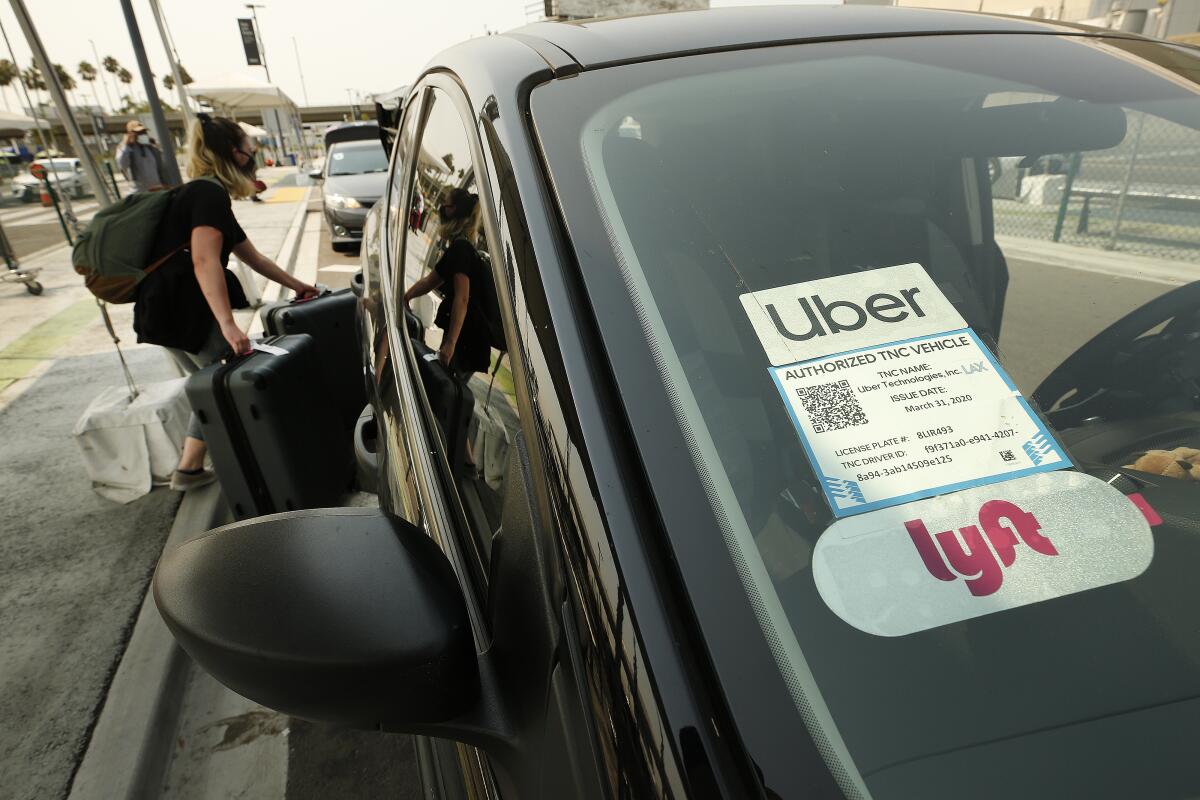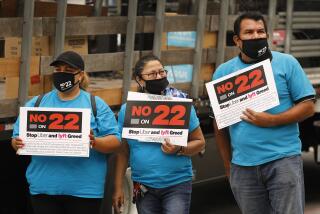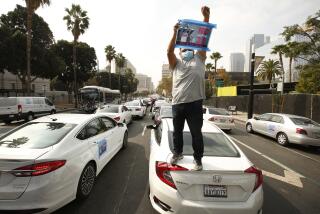Endorsement: No on Prop. 22. It’s the wrong solution for Uber drivers and the gig economy

- Share via
Proposition 22, which would classify drivers for app-based services such as Uber and Lyft as independent contractors but guarantee them certain benefits, is an ink-blot test.
If you think these companies are predators that exploit workers and compete unfairly, you’ll see the measure as yet another effort by the tech industry to circumvent the rules by which responsible corporate citizens play. If you think the apps provide workers an easy means to make extra money and consumers an affordable alternative to taxis, you’ll see Proposition 22 as a way to hold onto a service you value.
In reality, the measure is a fix designed by Uber and its counterparts for a problem the California Supreme Court created when it issued its Dynamex decision in 2018, making it harder for employers to classify workers as independent contractors. The Legislature, which is dominated by labor-friendly Democrats who see the gig economy as exploitative, embraced the Dynamex decision as a way to force changes in Uber and Lyft’s business model and promote unionized work.
But the ruling affects a broad array of industries, and the Legislature has failed to come up with a response that meets the needs of the state’s 21st century workforce. Unfortunately, Proposition 22 doesn’t provide a good answer either, offering a solution that’s too narrow and rigid.
Voters should reject the measure — even if doing so might wreak havoc on these services and their drivers, as Uber and Lyft say. Rather than accepting the bad bargain Proposition 22 presents, voters should demand a better, broader answer from Sacramento.
The heart of the problem here is that the state clings to an outdated idea of employment. It relies on decades-old statutes and legal decisions that divide workers into two types: employees and independent contractors. But as the late economist Alan B. Krueger and former Labor Secretary Seth D. Harris laid out in a 2015 paper for the Brookings Institution, technology has created a third type: independent workers who choose jobs made available through a variety of intermediaries, often blending personal and occupational pursuits. These workers exert more control over when and where they work than the typical employee, but they may have less control over their prices and other terms of service than the typical independent contractor. Krueger and Harris called on lawmakers to recognize this new category and provide labor protections equivalent to what employees enjoy while still preserving their flexibility.
The Dynamex decision, however, stuck with the 20th century framework and made it an even worse fit for the current economy. The court dramatically shifted the line separating employees from independent contractors, holding that anyone who performs work that is not “outside the usual course of the hiring entity’s business” is, in fact, an employee entitled to a minimum wage, overtime pay, workers’ compensation, unemployment insurance and any other benefit the state required employers to provide. Suddenly, companies across the state were faced with the prospect of having to hire as employees all the freelancers, casual laborers and other independent workers that performed tasks within the “usual course” of their businesses.
(The Los Angeles Times, like newspaper publishers across the state, were among those affected by the ruling. Along with full- and part-time employees, we use freelance reporters, writers and photographers, and independent contractors deliver copies of our papers to subscribers.)
The Legislature responded to the ruling last year with Assembly Bill 5, writing the ruling into state law with exceptions primarily for white-collar jobs (doctors, lawyers, investment advisors) and professional services. After a barrage of lobbying, the Legislature provided even more exemptions this year in AB 2257, including bigger carve-outs for freelance writers and photographers.
Notably absent from either list were app-based drivers, which is why Uber et al. pushed Proposition 22 onto the ballot. In effect, the measure would create a third category of employment: independent contractors who drive for app-based ride-hailing and delivery services. These workers would have to be paid at least 120% of the local minimum wage for the time they spend driving, receive a subsidy for health insurance if they drive more than 15 hours a week on average, be reimbursed for some expenses, be insured for medical costs and some loss of income if they’re injured on the job, and be protected against workplace discrimination.
The benefits are modest at best. Because drivers spend about a third of their time waiting to be summoned by a customer, the measure’s pay floor would translate to about 80% of the minimum wage. Drivers would be reimbursed at an initial rate of only 30 cents per mile, a little more than half the rate recognized by the Internal Revenue Service. They would have no paid sick days or family leave. There’s no provision to let them form a union.
Crucially for drivers, though, the proposition would preserve what they like most about working for these services: the complete control they wield over their hours. They decide when and where they work and for how long. The vast majority do so intermittently — part time in most cases, full time for a short period in others. But even drivers who put in full days behind the wheel say they like the flexibility to stop working at a moment’s notice and attend to family needs or other personal business. Although the value of that flexibility is hard to quantify, research shows that it’s real and significant.
It’s hard to imagine how the app-based services will be able to provide that same flexibility to drivers if they have to treat them as employees and provide the full panoply of protections, which would add 20% to 30% to the costs. The companies argue persuasively that if Proposition 22 fails, they will have to slash their driver rolls and assign workers to shifts and territories to make sure the service was available where it made economic sense to provide it. They also contend that they’d have to raise prices significantly in suburbs and rural areas.
More immediately, both companies assert that it would take them months to adapt their technology — which is designed to match riders on demand to whatever drivers are available — to a shift-based, AB 5-compliant model. That’s why, after the state won a court order in August compelling Uber and Lyft to comply with AB 5, both companies said they’d suspend their operations in the state unless an appeals court put the order on hold. (It did so.) If both Proposition 22 and the companies’ appeal fail, all drivers could find themselves without app-based work for some time. That could cost hundreds of thousands of Californians — many of them lower-income Black and brown workers — opportunities they count on to help make ends meet.
That would be a terrible outcome, but the alternative is even worse. Proposition 22 would cement into state law a measure that fails to deliver on a number of important fronts.
Not surprisingly for a labor law proposed by the app-based companies, the measure would continue to give transportation and delivery services a powerful incentive to cut costs by assigning core tasks to nonemployees. This is a particular problem for workers who put in a significant number of hours per week on the apps’ platforms.
Granted, it would be tricky to design a system that delivered a set of protections for these workers that were the functional equivalent of the ones for employees, but Proposition 22 doesn’t come close. Even conceding that Uber and Lyft have not been profitable, the sub-minimum-wage floor that the proposition would set under drivers’ earnings is unacceptable. And the proposition would bar the Legislature from making any changes to its terms without an all-but-impossible seven-eighths majority vote.
More important, the measure addresses only the app-based workers who drive, not the many other workers whose ability to work flexibly is threatened by the Dynamex decision and AB 5. A UC Berkeley study in 2017 found that 1 in 12 California workers listed their main source of income as independent contracting in 2016; only about 1 in 100 did work on “on-demand labor platforms,” such as Uber or TaskRabbit.
For all the hype about the gig economy and fears about it hollowing out the middle class, tax returns and other data don’t show a significant increase in the percentage of Americans doing “informal” work. Researchers say that about a quarter of adults 18 and older are earning income outside of a main job through such activities as babysitting, cleaning houses and yard work, with app-based work making up a very small percentage. According to a study by Dmitri Koustas of the University of Chicago, people take on this work primarily because they’ve lost a job or some of their income — and particularly for younger workers, app-based services have been significantly more lucrative than more traditional side hustles.
One of the key innovations of app-based companies is their ability to match whatever workers are available to the customers seeking services, enabling individual workers to come and go on their own schedule. The challenge for the state is to preserve that innovation while guarding against the exploitation of those who rely on app platforms for their livelihoods. And it’s a balance that must be struck broadly, not just for companies that lawmakers or voters favor. Proposition 22 doesn’t meet that challenge.
More to Read
A cure for the common opinion
Get thought-provoking perspectives with our weekly newsletter.
You may occasionally receive promotional content from the Los Angeles Times.










